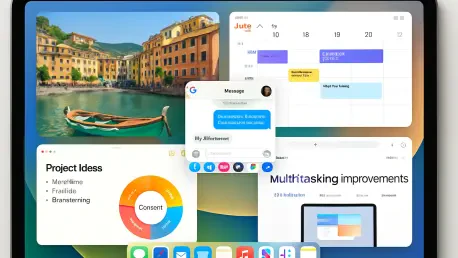The iPad has long been seen as a groundbreaking innovation in the tablet market, offering users a combination of portability and power. With the release of iPadOS 26, Apple has taken a bold step in bridging the functionality gap between the iPad and its Mac counterparts. This update comes with significant enhancements that make the iPad a more formidable device, blurring the lines between tablets and traditional computers. Key among these changes are new multitasking capabilities, interface updates, and cross-device similarities, each contributing to a more Mac-like user experience on the iPad.
Elevating Multitasking and Window Management
Enhanced Multitasking Capabilities
The multitasking capabilities introduced in iPadOS 26 mark a significant evolution in how users can manage multiple applications. Previous iterations of the iPad had limited functionality with options like Slide Over and Split View, which allowed apps to be run side by side but were somewhat restrictive in terms of flexibility. Now, users can handle multiple app windows in a fashion similar to macOS, opening up possibilities that had been previously unavailable on a tablet. Significantly, users can not only move and layer windows but choose a full-screen or multitasking mode based on personal preference. This opt-in feature allows individuals to tailor their iPad experience according to their needs, whether casual or professional.
Furthermore, while Slide Over and Split View have been retired, the Stage Manager remains an option for those who enjoy organizing apps and workspaces in a grouped manner. Apple’s decision to incorporate Mac-like elements, such as movable app windows and a Mac-style menu bar, fundamentally alters how iPads can be used in professional environments, making them more adaptable tools for productivity. This transition highlights Apple’s ongoing strategy to make its devices more versatile, catering to a wide array of users ranging from casual consumers to professionals who require more robust computing capabilities.
Introducing Mac-Like UI Elements
In addition to improved multitasking, iPadOS 26 includes a set of UI enhancements aimed at enriching user interface experiences by adopting features reminiscent of macOS. One notable addition is the incorporation of a Mac-like menu bar within applications, providing users with easy access to relevant options within each app. This feature requires app developers to update their apps to fully utilize the menu bar, showcasing a collaborative effort between Apple and developers to optimize applications for modern user demands.
Moreover, the inclusion of traffic light buttons—similar to those found on Macs—for managing windows exemplifies how iPadOS is drawing closer to the Mac ecosystem. Users can minimize, maximize, and close windows with familiar ease, a seemingly small addition that increases efficiency and user satisfaction. The introduction of a Mac-style arrow cursor accessible via the Magic Keyboard’s trackpad furthers this convergence, allowing for smoother input methods that appeal to users accustomed to more traditional computing devices.
Additional Features Beyond Multitasking
Improved File Management and Personalization
Beyond multitasking, iPadOS 26 brings extensive improvements to the Files app, a critical tool for users relying on the iPad for work-related tasks. One of the standout features is the Mac-style list view within the Files app, providing a more organized and streamlined approach to managing files. This is further enhanced by features like resizable columns and customizable folders, letting users organize their digital workspace and tailor it to their preferences using colors and emojis.
The capability to select default apps for specific file types is a particularly valuable addition, granting power users more control over how different files are handled. This feature aligns with a broader trend of allowing users to personalize their devices in ways that make them more functional for individual workflows, accentuating the iPad’s role as a productivity device. Additionally, enhancements to background tasks mean users can engage in lengthy activities like downloading or exporting without disrupting their workflow, thanks to the Live Activity interface that keeps them informed of task progress.
Incorporating Communication Tools
A groundbreaking development in iPadOS 26 is the introduction of the Phone app, allowing iPads to make calls via Wi-Fi when connected to an iPhone. This feature signals a significant departure from traditional tablet functionality, fusing capabilities that are more often associated with smartphones into the tablet environment. Although not every user may find this addition indispensable, the ability to use Call Screening, Live Translation, and Hold Assist expands the iPad’s usability beyond conventional applications. This integration showcases Apple’s vision of a more connected ecosystem where different devices seamlessly communicate and function together, ensuring users have access to comprehensive tools regardless of the primary device in use.
Aligning with iOS and Ensuring Stability
Seamless Integration Across Apple Devices
While iPadOS 26 introduces numerous updates tailored to the iPad, many of these improvements have roots in iOS 26, extending beyond a single device type. Applications like Messages, Apple Music, Photos, and Camera encompass updates that contribute to a cohesive user experience across both iPads and iPhones. This seamless integration not only enriches the user experience but also reinforces Apple’s commitment to a unified ecosystem where each device complements the others. This strategy encourages users to operate within the Apple environment, maximizing the benefits of interconnected devices that share similar interfaces and functionalities.
Testing and Feedback for a Stable Release
The release of iPadOS 26 involves a structured cycle beginning with developer and public beta access, signaling Apple’s intent to ensure reliability and address potential issues before a full rollout. While Apple’s rigorous testing helps in delivering a largely stable update, users are advised to back up their devices, especially when using them for critical tasks. Despite iPadOS 26’s relative stability, as with any beta software, the presence of bugs is anticipated, and user feedback plays a pivotal role in refining the final release.
The parallels drawn between iPadOS 26’s features and those found on the Mac serve to elevate the iPad’s functionality, blurring the lines between what constitutes a tablet and a traditional computer. By aiming for integration and versatility, the iPad shifts from being perceived merely as a leisure device to emerging as a contender in professional and productivity spaces.
Transitioning to a Hybrid Device Model
Competing in the Computing World
The updates in iPadOS 26 significantly enhance the iPad’s capabilities, aligning it more closely with traditional computers while maintaining its touch-centric approach. This hybrid model creates opportunities for the iPad to serve both casual users and professionals, offering a platform that supports diverse needs without compromising the strengths inherent to each category. For creative professionals, the iPad provides an intuitive interface for hands-on applications, whereas office professionals might find the enhanced multitasking and file management features particularly useful for productivity tasks.
The strategic direction Apple has taken with iPadOS 26 suggests a long-term vision of creating devices that are adaptable to various user requirements. This adaptability allows Apple to remain at the forefront of the technology market, where consumers increasingly demand multifunctional devices capable of fulfilling both entertainment and professional needs. By integrating Mac-like attributes into the iPad, Apple opens up opportunities for the device to serve in roles traditionally occupied by laptops and desktops, without sacrificing the mobility and user-friendly aspects that have made tablets popular.
Future Considerations for Apple Devices
The iPad has consistently been recognized as a groundbreaking innovation in the tablet market, offering a unique fusion of portability and power. Apple, with the release of iPadOS 26, has ventured into new territory, closing the divide between the iPad and Mac computers. This update is notable for its substantial enhancements that elevate the iPad’s standing as a powerful device, further blurring the line between tablets and conventional computers. At the forefront of these improvements are advanced multitasking capabilities, interface modifications, and cross-device similarities that together foster a more Mac-like user experience on the iPad. These changes reflect Apple’s commitment to creating a seamless, integrated experience for users, whether they’re working on a Mac or an iPad. By pushing these boundaries, Apple not only reinforces the iPad’s versatility but also strengthens its position as a key player in the evolving landscape of mobile technology.









